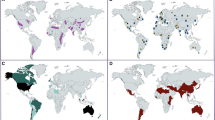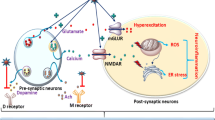Abstract
The potent olfactory toxicant 2,6-dichlorophenyl methylsulphone (2,6-diClPh-MeSO2) induces rapid cell death and long-term metaplastic changes in the olfactory regions of rodents. The damage is related to a tissue-specific and extensive cytochrome P450 (CYP)-mediated metabolic activation of the compound to reactive intermediates. The aim of the present study was to examine the early, cell-specific changes leading to cell death in the olfactory mucosa of mice exposed to 2,6-diClPh-MeSO2. We have examined the expression of the ER-specific stress protein GRP78, the presence of secretory glycoproteins, and the cellular activation of the initiator caspase 12 and the downstream effector caspase 3. 2,6-DiClPh-MeSO2 induced rapid and cell-specific expression of GRP78, and activation of caspases 12 and 3 in the Bowman’s glands. No similar early onset changes in the neuroepithelium were observed. Based on these results, we propose that extensive lesions are initiated in the Bowman’s glands and that the metabolic activation of 2,6-diClPh-MeSO2 elicits ER-stress response and subsequent apoptotic signaling at this site. Since most of the Bowman’s glands had oncotic morphology, the results suggest that the terminal phase of apoptosis was blocked and that these glands finally succumb to other routes of cell death.





Similar content being viewed by others
References
Bahrami F, Bergman U, Brittebo EB, Brandt I (2000a) Persistent olfactory mucosal metaplasia and increased olfactory bulb glial fibrillary acidic protein levels following a single dose of methylsulphonyldichlorobenzene in mice: comparison of the 2,5- and 2,6-dichlorinated isomers. Toxicol Appl Pharmacol 162:49–59
Bahrami F, van Hezik C, Bergman A, Brandt I (2000b) Target cells for methylsulphonyl-2,6-dichlorobenzene in the olfactory mucosa in mice. Chem Biol Interact 128(2):97–113
Carlsson C, Bahrami F, Fredriksson A, Brandt I (2002) Behavioural changes related to olfactory mucosal metaplasia and bulbar glial fibrillary acidic protein (GFAP) induction in methylsulphonyl-dichlorobenzene-treated mice. Arch Toxicol 76(8):474–483
Ding X, Kaminsky LS (2003) Human extrahepatic cytochromes P450: function in xenobiotic metabolism and tissue-selective chemical toxicity in the respiratory and gastrointestinal tracts. Annu Rev Pharmacol Toxicol 43:149–173
Eriksson C, Brittebo EB (1991) Metabolic activation of the herbicide dichlobenil in the olfactory mucosa of mice and rats. Chem Biol Interact 79(2):165–177
Franzen A, Carlsson C, Brandt I, Brittebo EB (2003) Isomer-specific bioactivation and toxicity of dichlorophenyl methylsulphone in rat olfactory mucosa. Toxicol Pathol 31(4):364–372
Hitomi J, Katayama T, Taniguchi M, Honda A, Imaizumi K, Tohyama M (2004) Apoptosis induced by endoplasmic reticulum stress depends on activation of caspase-3 via caspase-12. Neurosci Lett 357(2):127–130
Kern JC, Kehrer JP (2002) Acrolein-induced cell death: a caspase-influenced decision between apoptosis and oncosis/necrosis. Chem Biol Interact 139(1):79–95
Kern RC, Conley DB, Haines GK 3rd, Robinson AM (2004) Pathology of the olfactory mucosa: implications for the treatment of olfactory dysfunction. Laryngoscope 114(2):279–285
Leist M, Jaattela M (2001) Four deaths and a funeral: from caspases to alternative mechanisms. Nat Rev Mol Cell Biol 2(8):589–598
Liu H, Bowes RC III, van de Water B, Sillence C, Nagelkerke JF, Stevens JL (1997) Endoplasmic reticulum chaperones GRP78 and calreticulin prevent oxidative stress, Ca2+ disturbances, and cell death in renal epithelial cells. J Biol Chem 272(35):21751–21759
McMillan Carr V, Menco BP, Yankova MP, Morimoto RI, Farbman AI (2001) Odorants as cell-type specific activators of a heat shock response in the rat olfactory mucosa. J Comp Neurol 432:425–439
McMillan Carr V, Ring G, Youngentob SL, Schwob JE, Farbman AI (2004) Altered epithelial density and expansion of bulbar projections of a discrete HSP70 immunoreactive subpopulation of rat olfactory receptor neurons in reconstituting olfactory epithelium following exposure to methyl bromide. J Comp Neurol 469(4):475–493
Mery S, Gross EA, Joyner DR, Godo M, Morgan KT (1994) Nasal diagrams: a tool for recording the distribution of nasal lesions in rats and mice. Toxicol Pathol 22(4):353–372
Nakagawa T, Yuan J (2000) Cross-talk between two cysteine protease families. Activation of caspase-12 by calpain in apoptosis. J Cell Biol 150(4):887–894
Schwab BL, Guerini D, Didszun C, Bano D, Ferrando-May E, Fava E, Tam J, Xu D, Xanthoudakis S, Nicholson DW, Carafoli E, Nicotera P (2002) Cleavage of plasma membrane calcium pumps by caspases: a link between apoptosis and necrosis. Cell Death Differ 9(8):818–831
Simpson SA, Alexander DJ, Reed CJ (2004) Heat shock protein 70 in the rat nasal cavity: localisation and response to hyperthermia. Arch Toxicol 78(6):344–350
Simpson SA, Alexander DJ, Reed CJ (2005) Induction of heat shock protein 70 in rat olfactory epithelium by toxic chemicals: in vitro and in vivo studies. Arch Toxicol 79(4):224–230
Suzuki Y, Farbman AI (2000) Tumor necrosis factor-alpha-induced apoptosis in olfactory epithelium in vitro: possible roles of caspase 1 (ICE), caspase 2 (ICH-1), and caspase 3 (CPP32). Exp Neurol 165(1):35–45
SFS (1988) 2005-02-28, 45. Swedish Animal Welfare Agency, Skara, Sweden (see http//:www.djurskyddsmyndigheten.se/jahia/Jahia/lang/en/pid/2)
van De Water B, Wang Y, Asmellash S, Liu H, Zhan Y, Miller E, Stevens JL (1999) Distinct endoplasmic reticulum signaling pathways regulate apoptotic and necrotic cell death following iodoacetamide treatment. Chem Res Toxicol 12(10):943–951
Welihinda AA, Tirasophon W, Kaufman RJ (1999) The cellular response to protein misfolding in the endoplasmic reticulum. Gene Exp 7(4–6):293–300
Young JT (1981) Histopathologic examination of the rat nasal cavity. Fundam Appl Toxicol 1(4):309–312
Acknowledgements
We thank Raili Engdahl and Lena Norgren for excellent technical assistance. We are indepted to Dr. Christina Larsson and Professor Åke Bergman, Department of Environmental Chemistry, Stockholm University, for synthesis of the substance. Financial support was given by the Swedish Research Council.
Author information
Authors and Affiliations
Corresponding author
Rights and permissions
About this article
Cite this article
Franzén, A., Brittebo, E.B. Toxicant-induced ER-stress and caspase activation in the olfactory mucosa. Arch Toxicol 79, 561–570 (2005). https://doi.org/10.1007/s00204-005-0670-8
Received:
Accepted:
Published:
Issue Date:
DOI: https://doi.org/10.1007/s00204-005-0670-8




